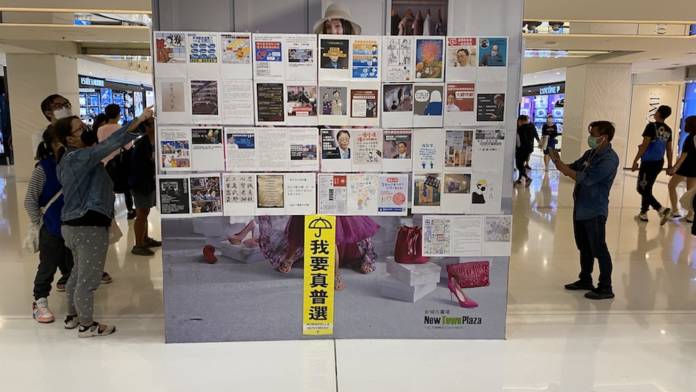
My wife (she prefers that label) and I travel to the Hong Kong Special Administrative Region each year to visit her relatives, in particular, her aging mother. This year, like the last four years, our visit occurred during the lunar Chinese New Year.
CNY in Hong Kong is a time of heightened activity for most families. Large family and social gatherings, special foods, timely rituals, visits to the temple or cemetery, the distributing of red lai seepackets containing “lucky money” to friends and family, dragon and lion dances, a huge parade and fireworks typically punctuate the widely celebrated holiday.
This time there was nothing normal about visiting Hong Kong during CNY. In fact, since 1991, it was the strangest visit we’ve ever made.
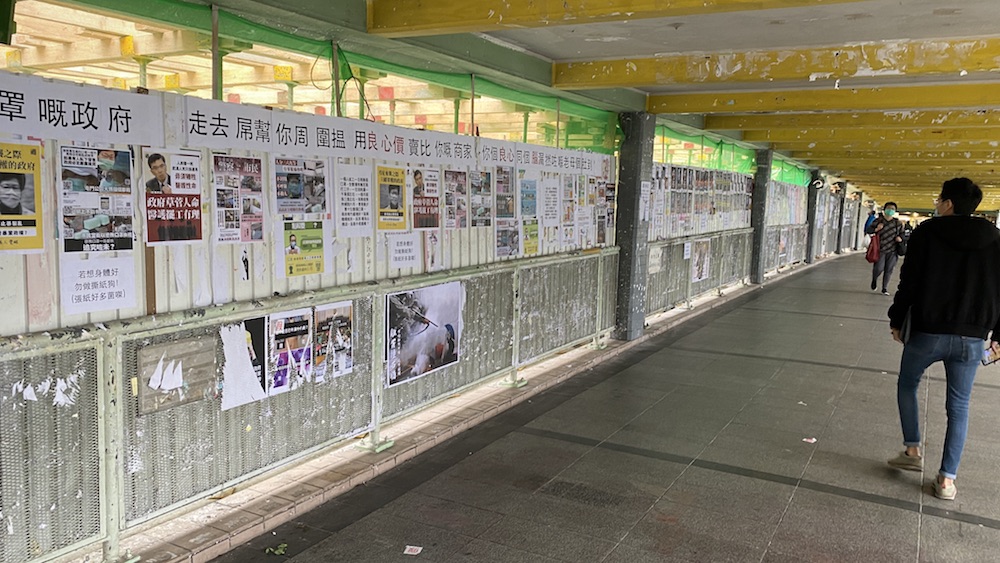
For the last eight months before the 2020 holiday, peaceful demonstrators with numbers as high as two million were in the streets demanding changes to many of their government’s policies, in particular, the Extradition Bill. Also, intense street battles between black clad youth and police had become a regular nightly event. Furthermore, when we arrived in Hong Kong in the early morning of February 3, there were already 15 known cases of COVID-19 in the region. The first ten cases were thought to have arrived in HK from mainland China. The locked down city of Wuhan, China, the epicenter for the COVID-19 pandemic, is only 530 miles from Hong Kong.
We each wore a mask upon arriving at SFO and once inside the cabin, we sanitized our seating area, too.
Upon arrival at the Hong Kong International Airport, I saw that practically everyone in the vast arrival terminal was wearing a mask of some kind; the exceptions, Westerners. In previous years, only local people with an illness tended to wear a mask.
When we checked into our hotel in the New Territories town of Sha Tin, we learned that the occupancy rate was about 20 percent and that the floor where our room was located was closed. The hotel had already begun to sanitize interior spaces, had closed its restaurants and swimming pool, and imposed mandatory temperature checks upon entering the building.
The hotel itself is situated inside the Sha Tin New Town Center complex. With 300 to 500 people residing normally in the hotel and thousands of residents living in the apartment blocks attached to the complex, there is routine competition for access to the elevators and the escalators. That wasn’t happening that morning.
In the past, during Chinese New Year, the New Town complex was replete with the trappings of the celebration. The year’s animal sign was deployed in small and large colorful displays, Choi Sun Doe characters made the rounds handing out lucky money, lion dances with those pounding drums and clapping hand cymbals were present, locals returning from temples proudly carried “luck changing” pinwheels, shoppers vied for special foods and families passed spiritedly through the complex on their way to visit relatives or a shrine. That ambience generated a constant flow of people through the complex.
As we entered the New Town Center Complex that morning, it was nearly empty. Even without New Year celebrations, typically, the complex is a vibrant commercial center with more than two hundred boutiques, supermarkets, restaurants and banks. Add the New Year to the complex and it is very, very crowded. So, where was everyone? Later, we learned that schools were already closed, and government workers were staying at home as a result of COVID-19. Many residents were staying at home as well. And the probability of demonstrators and police mixing it up kept shoppers away.
Most importantly for us, the Sha Tin New Town Center complex has an train station on the East Rail Line which takes us directly to Fanling, another New Territories town, where my wife’s mother lives. Normally busy at all times as not many residents own or drive a car, the station platform looked abandoned.
Once out of the train and into the Fanlng station, there were signs of a struggle as several walls and ceilings had not been so completely stripped of a massive amount of protest posters. Later, as we would go back and forth to Mom’s place, a wall full of posters criticizing government leaders, their policies and the police, would go up in the afternoon and then get taken down early the next morning.
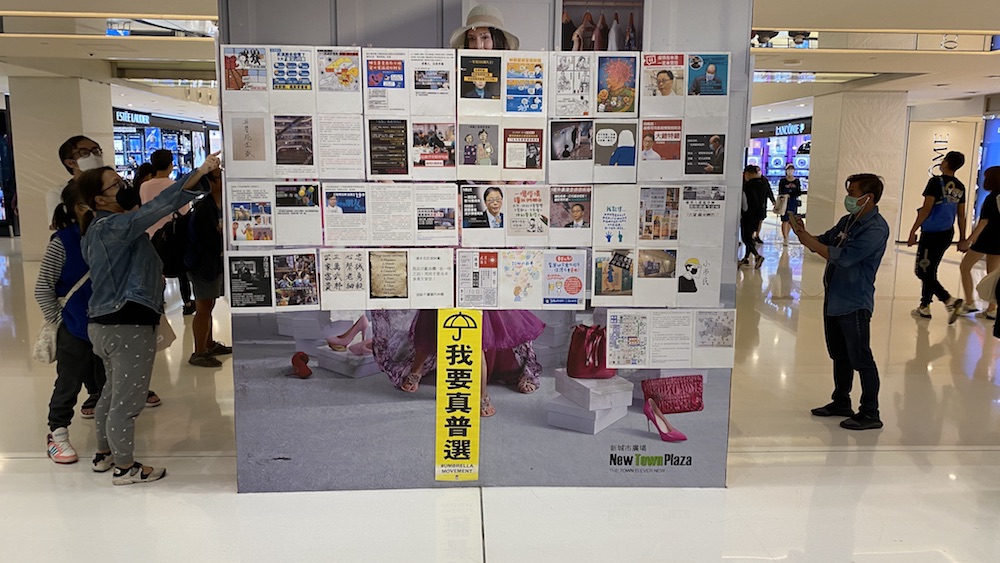
During our first visit to her mother’s small apartment in Fanling, we learned the senior center she uses was closed. But there was no government order to shelter in place.
On that same day, we unloaded about one half of the items we brought for her mom to use as well as set in motion a plan to deal with maintenance and equipment issues. Also, we went out for dim sum, let Mom take a serious nap, played a little Mahjong, watched Cantonese “golden oldie” TV programs, went for a short walk and took care of essential quality-of-life errands for her.
Later, upon our return to Sha Tin that evening, as soon as we departed the train station, we walked into a small demonstration in progress inside the New Town Center Complex. There were now protest posters attached to two of the main columns in the New Town Center Plaza. Two women wearing masks were handing out fliers and small white ribbons in support of a strike by a 3,000-member hospital workers’ union seeking better protective gear to fight the virus and demanding that the Hong Kong government close the border with mainland China, the source of many people ill with the virus who were arriving in Hong Kong. Hong Kong shares a 19-mile land border with mainland China.
That night, on a local Cantonese cable news channel, there were extensive medical reports, interviews with striking nurses, government leaders and demonstrators expressing their points of view about the virus, talk of government action or inaction, protests at proposed quarantine sites, sanitation workers complaining about the lack of protective gear as well as updates about mainland China’s latest efforts to contain the virus.
This was not going to be a time of celebrations for prosperous new year.
That was just the first day.
Almost every day that followed for nearly five weeks had a simple routine as our raison d’etrefor visiting Hong Kong was to improve the quality of life for my wife’s mother. We had a job to do. And we had only so many days to complete the job. And so, we moved between contested and living spaces each day.
Typically, we awoke early. Before leaving for breakfast, we put on put our masks. We ate breakfast in a special room in the hotel in a controlled space where our temperatures were checked before we entered. After breakfast, we sanitized our hands. We prepared for our Mom visit by bringing with us extra masks and sanitizer. Before departing, we washed and sanitized our hands again. After riding the train, we applied more hand sanitizer and walked 20 minutes to her apartment.
We took off our masks while visiting. Our visiting hours were generally from 11am to 5pm. That when completed our errands, too.
We would return by train to Sha Tin in late afternoon or early evening to find some small demonstration occurring at the New Town Center Plaza. Typically, more than100 posters were taped to the two main columns in the plaza. The messages on the posters made fun or government leaders or opposed to the policies of the Hong Kong government. There were always people reading the posters. There were security personnel wearing yellow wind breakers with security badges standing not far from this scene (photo #8).
After eating dinner, each night on a cable news channel or on the Hong Kong public TV cable channels, that is, Radio Television Hong Kong, there were extensive local reports of the impact of the virus, reports on actions taken by mainland China to contain the virus, criticism of the lack of decisive action by Hong Kong government and reports internationally regarding the impact of the virus.
Hong Kong was a British Crown colony for over 140 years. So there is plenty of English language media available to westerners. When that media wasn’t available, my wife, born and raised in Hong Kong, was an excellent translator of the Cantonese dialect.
Beside the experiences encountered by the regularly of our schedule, there were some surprises.
On Saturday, February 8, inside the New Town Center Plaza, black clad demonstrators wearing masks with a microphone and small speaker and many small folding chairs momentarily seized a piece of the plaza. According to my wife, they were making a proclamation in support of front line workers struggling to protect themselves from the COVID-19.
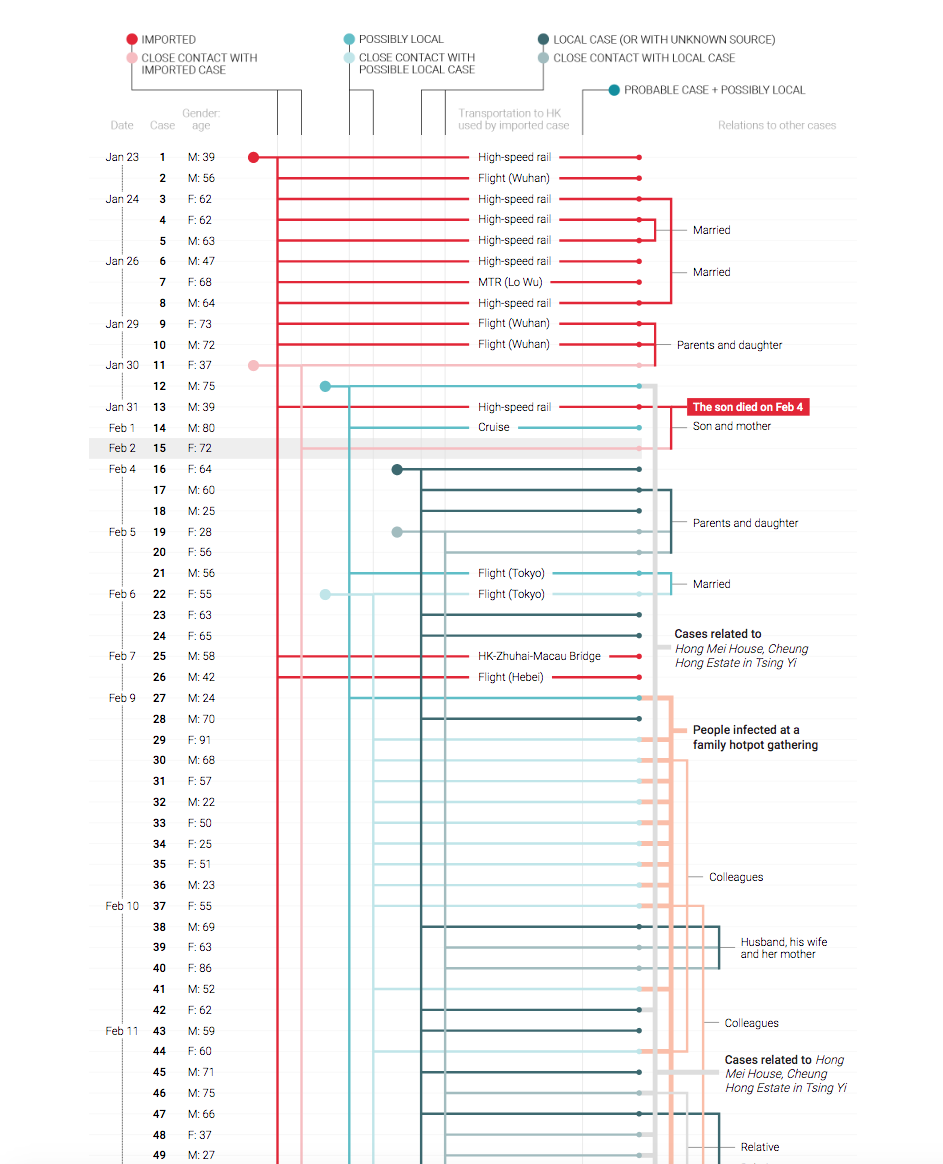
In the Tuesday, February 11 edition of the English language South China Morning Post, a graphic covered an entire page detailing each case to date with the age, gender, place of residence, possible contact source, how each case got to Hong Kong, relations to other case, the source of the infection and the status of the infected person. At that point, there were 49 cases of infection and one death.
The morning of Saturday, February 15, my wife left very early to take her mother to an eye specialist. About an hour later, from our hotel room, I heard shouting outside my window. I looked out to see demonstrators holding signs and chanting in Cantonese as police vehicles moved slowly through the crowd. In five minutes, I was in the protest space. I learned that in July 2019 in the New Town Center, a man (now in one the police vans) had been arrested for poking a police officer with an umbrella during a pitched battle between police and demonstrations. The man was being sentenced today and there about 60 – 80 people of all ages gathered outside the Law Court supporting the man. The protest lasted about another 90 minutes.
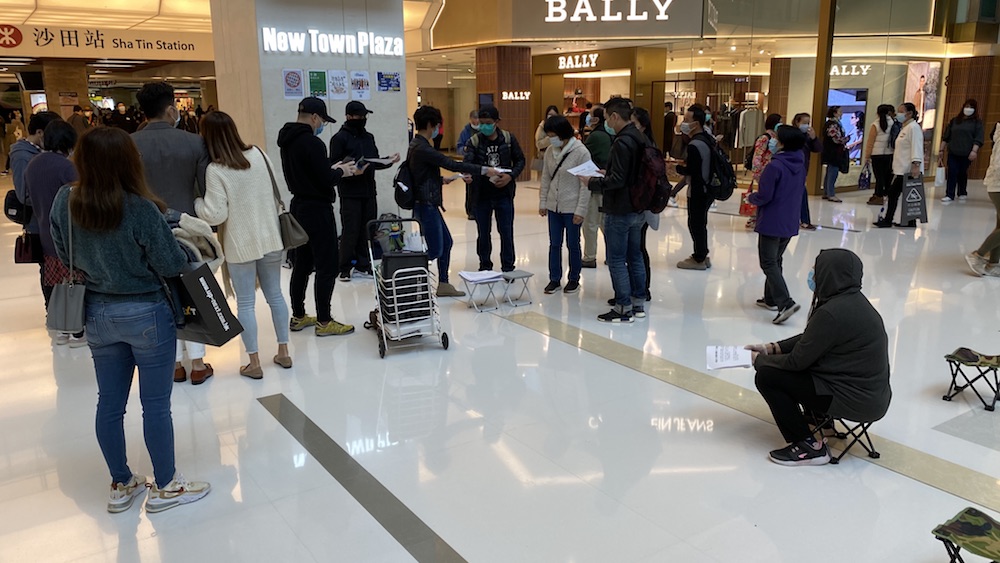
On Friday, February 21, it was widely reported that a police officer, who had been infected with the virus at a noodle shop in Yau Dong, had attended a farewell banquet party for a retiring officer with 59 other officers. Four came down with the COVID-19 symptoms and the rest went into quarantine. Not only did the infected officer not wear a mask to the event but he also attended a gathering of a large number of people. At the time, there were government guidelines in place for wearing a mask in public and avoiding large social gatherings.
On Friday, February 28, demonstrators momentarily seized a piece of the New Town Center plaza but this time a taped recording played over a laptop computer. Again, demonstrators wearing masks had seized a piece of the plaza and were counting the claims made by the HK government that the demonstrators were rioters. Their statements were made in the presence of the New Town security personnel in the yellow windbreakers.
The evening of Saturday, February 29, for about three hours, we watched a live feed of a roving protest across the Mong Kok District of Hong Kong on RTHK, the public TV station. Police and demonstrators were alternatively confronting and moving away from each other. There was generally little audio as the use of expletives was extensive. When there was audio, the crowds on the sidewalks watching events were cursing the police.
Sunday, March 1, the protest posters in the New Town Center Plaza had a noticeable addition: A yellow flier from the 2014 Umbrella Movement. An echo of an earlier passive resistance struggle for greater democracy in Hong Kong, when demands for universal suffrage were ignored by the government, that effort could claim to be the roots for the current upheaval across Hong Kong.
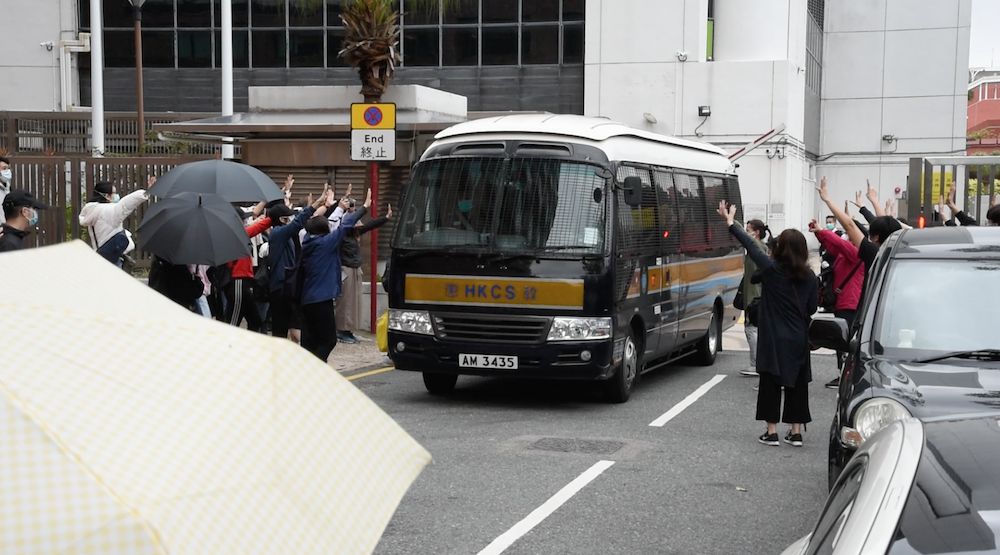
As we preparing to depart for San Francisco on March 5, our thoughts were on our own possible quarantine. Even though we exhibited no symptoms of the virus, the incubation period was still an issue. My expectations, due in part to media coverage of the virus infections in the bay area and of precautions at SFO in the case of passengers arriving from Mainland China, were such that we’d be quarantined for a least 14 days upon arrival.
We didn’t know if Hong Kong would be considered a part of mainland China or apart from Mainland China.
At customs and immigration at SFO, we were only asked if we had recently visited Iran or mainland China. We replied no. That was it. We were allowed to walk into the baggage claim area and then headed home.
Now that we are under the shelter in place order issued by Mayor Breed, we understand that there is no such order in Hong Kong.
Herb Mintz lives in San Francisco.
